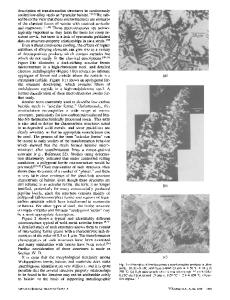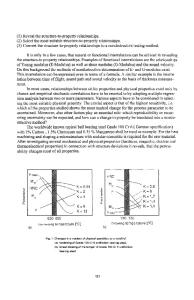Microstructure-mechanical property relationships of dual-phase steel wire
- PDF / 4,039,541 Bytes
- 10 Pages / 612 x 792 pts (letter) Page_size
- 72 Downloads / 385 Views
I.
INTRODUCTION
T w o of the many requirements for automobile sheet steels are high strength and good formability. The high strength permits the use of thinner gauge sheet resulting in lighter and more fuel efficient automobiles, and the often conflicting requirement of good formability is necessary if the steel is to be stamped into the complex shapes of automobile parts. A class of steel recently designed to meet these requirements is a high strength, low alloy steel known as dual-phase steel. ~'2'3 Since its introduction, considerable research effort has been directed toward understanding and improving this steel as reported at five symposia on the subject.4-8 As discussed in these symposia, the basis of dual-phase steel is that of a composite. Despite the generic name "dual-phase", such steel may contain three or more phases. The matrix is usually soft ductile ferrite. The strengthening phase(s), which comprises 10 to 40 vol pct, is mainly hard, strong martensite but may contain small amounts of bainite or retained austenite. The mechanical properties typical of this composite microstructure include low yield strength, continuous yielding, high initial work hardening rate, high tensile strength, good ductility, and good formability. The high initial work hardening is typical of materials consisting of a hard dispersion in a soft matrix. Such a composite provides a high tensile strength despite a low yield strength and suppresses the onset of necking in uniaxial tension tests to yield high uniform elongation values. More importantly for sheet applications, plastic instability is suppressed in multiaxial metal forming operations to yield improved formability. 9 In addition to flat rolled products, the potential of dual-phase steel for line-pipe applications, especially at low temperatures, has also been demonstrated. 1~In the present work an attempt has been made to draw upon the many advantages of this composite microstructure to produce high A.H. NAKAGAWA is Senior Metallurgical Engineer, Engineering Technology Department, Westinghouse Electric Corporation, Sunnyvale, CA 94088. G. THOMAS is Professor, Department of Materials Science and Mineral Engineering, University of California, Berkeley, CA 94720, and Scientific Director, National Center for Electron Microscopy, Lawrence Berkeley Laboratory, Berkeley, CA 94720. Manuscript submitted May 8, 1984. METALLURGICALTRANSACTIONS A
strength rods and wire. One objective was to study the high strain deformation behavior of dual-phase steels during wire drawing in terms of the structure of highly deformed ferrite and martensite, the difference in strain between the hard and soft phases, and the formation of voids that result from this difference. Except for a fundamental defomaation study by Korzekwa et al., 1~ very little is known about wire drawing of dual-phase steel. The other objective was to determine the effect of the initial microstructure, i.e., martensite particle size, shape, strength, volume fraction, and distribution within the ferrite matrix, on the pr
Data Loading...










